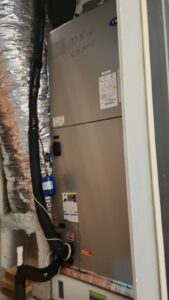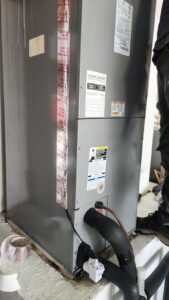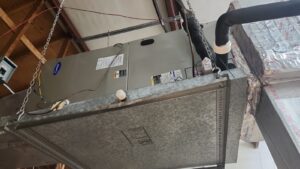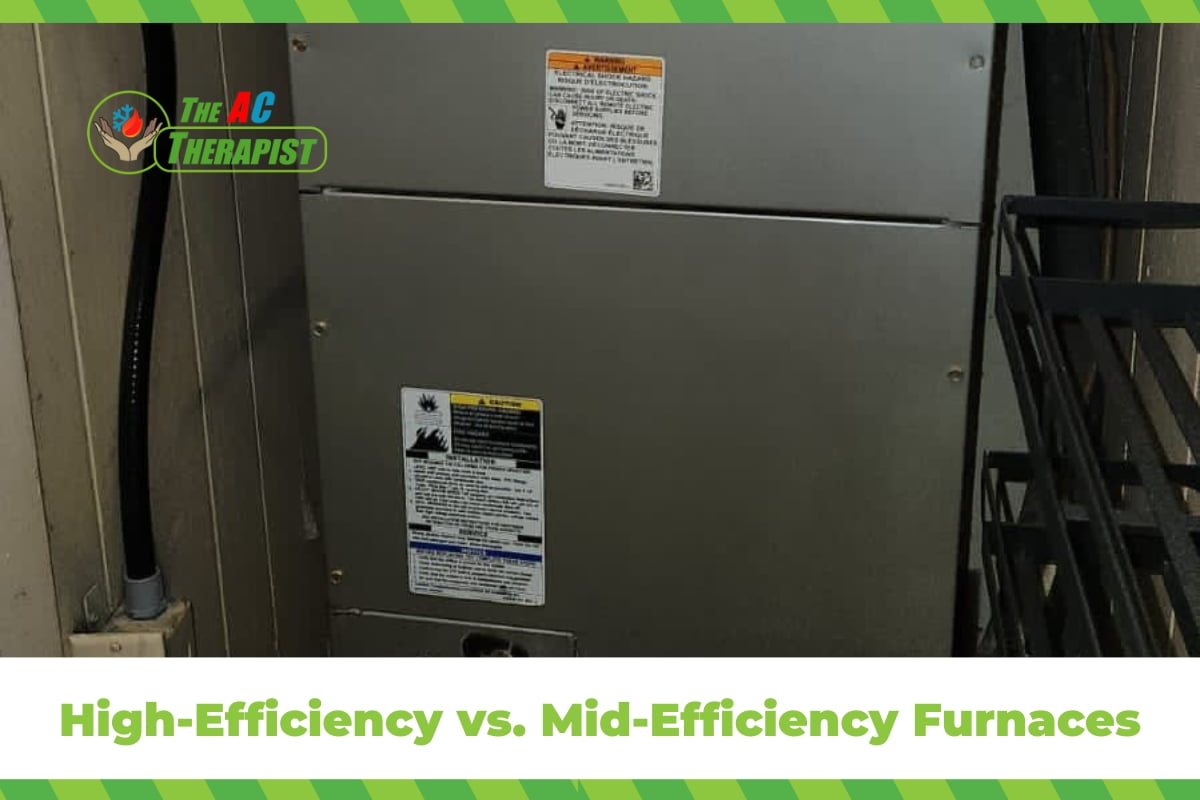High-Efficiency vs. Mid-Efficiency Furnaces
Hello and welcome to our comprehensive guide on furnaces! I’m your host and guide, The AC Therapist, a dedicated professional in the HVAC industry, specializing in bringing comfort and efficiency to homes in the Tampa Bay area. Today, I’m here to navigate you through one of the most crucial decisions you’ll make as a homeowner – choosing the right furnace for your home.
The importance of this decision cannot be overstated. Your furnace is not just a piece of equipment; it’s the heart of your home’s heating system, a key player in your family’s comfort during those cooler months, and a significant factor in your energy bills. But with so many options out there, how do you know which furnace is right for you? That’s where I come in.
As The AC Therapist, I believe in empowering homeowners with knowledge. Understanding the ins and outs of furnace efficiency is the first step in making an informed decision. Furnace efficiency is measured by the Annual Fuel Utilization Efficiency (AFUE) rating – a percentage that tells you how much fuel your furnace can convert into heat. The higher the AFUE rating, the more efficient the furnace.
In this guide, we’ll delve into the world of high-efficiency and mid-efficiency furnaces. We’ll explore their pros and cons, and I’ll share insights to help you weigh these options against your specific needs, considering factors like your home’s size, your climate, and your budget.
Choosing the right furnace is a significant decision, and I’m here to ensure you have all the information you need to make the best choice for your home. So, let’s get started and turn up the heat on furnace knowledge!

How Efficiency is Measured: Understanding AFUE Ratings
When it comes to furnace efficiency, the key metric used is the Annual Fuel Utilization Efficiency (AFUE) rating. This rating, expressed as a percentage, measures how efficiently a furnace can convert the energy in its fuel to heat over a typical year.
- AFUE Explained: Simply put, the AFUE rating indicates the proportion of fuel transformed into heat versus the amount lost in the heating process. For example, a furnace with an AFUE rating of 80% means that 80% of the fuel is used for heating, while the remaining 20% is lost, often through venting.
- Interpreting AFUE: Higher AFUE ratings indicate higher efficiency. A furnace with a 90% AFUE rating is more efficient than one with an 80% rating. This efficiency can significantly impact your energy bills and environmental footprint.
High-Efficiency Furnaces: Pros and Cons
Pros:
- Energy Savings: High-efficiency furnaces, typically with AFUE ratings of 90% or above, convert most of the fuel into heat, meaning less energy is wasted and more savings on your heating bills.
- Environmental Friendliness: With higher efficiency, these furnaces emit fewer greenhouse gases, making them a more eco-friendly option.
- Advanced Technology: They often come equipped with modern features like variable-speed blowers and modulating gas valves, providing more consistent and comfortable heat distribution.
- Rebates and Tax Incentives: Purchasing a high-efficiency furnace can qualify you for certain tax credits and rebates, helping offset the initial cost.
Cons:
- Higher Initial Cost: The advanced technology in high-efficiency furnaces typically comes with a higher upfront price tag compared to mid-efficiency models.
- Complex Installation: They may require additional installation steps, such as special venting, which can increase installation costs.
Mid-Efficiency Furnaces: Pros and Cons
Pros:
- Lower Initial Investment: With AFUE ratings between 80% and 89%, mid-efficiency furnaces are generally more affordable upfront than high-efficiency models.
- Easier Installation: These furnaces usually have less complex installation requirements, potentially leading to lower installation costs.
Cons:
- Higher Operating Costs: Mid-efficiency furnaces are less efficient in converting fuel to heat, leading to higher energy bills over time compared to high-efficiency models.
- Environmental Impact: They are less efficient and, therefore, emit more greenhouse gases compared to high-efficiency furnaces.

High-Efficiency Furnaces vs. Mid-Efficiency Furnaces
When it comes to selecting a furnace for your home, understanding the differences between high-efficiency and mid-efficiency models is crucial. Both types offer distinct benefits, and the best choice for you will depend on your specific needs, preferences, and circumstances. Let’s explore the key benefits of each to help you make an informed decision.
High-Efficiency Furnaces:
- Energy Savings: The most significant benefit of high-efficiency furnaces is their energy-saving potential. With AFUE ratings typically above 90%, these furnaces convert a higher percentage of fuel into usable heat. This efficiency translates to lower energy bills, making them a cost-effective choice in the long run, especially in regions with harsh winters where the furnace runs frequently.
- Environmental Impact: High-efficiency furnaces are more environmentally friendly. By consuming less fuel and converting it more effectively into heat, they reduce your home’s carbon footprint. This aspect is particularly appealing to homeowners who prioritize eco-friendly living.
- Advanced Features: These furnaces often come equipped with the latest technology, such as variable-speed blowers and modulating gas valves. These features allow for better temperature control, increased comfort, and quieter operation.
- Potential Rebates and Incentives: Many regions offer rebates and incentives for installing high-efficiency furnaces, which can help offset the higher initial cost.
Mid-Efficiency Furnaces:
- Lower Initial Cost: One of the primary benefits of mid-efficiency furnaces, with AFUE ratings typically between 80% and 89%, is their lower upfront cost compared to high-efficiency models. This makes them an attractive option for homeowners on a tight budget or those who don’t plan to stay in their homes long-term.
- Reliability and Simplicity: Mid-efficiency furnaces often have simpler designs with fewer components than high-efficiency models. This simplicity can translate to fewer maintenance issues and potentially longer life spans, as fewer parts can fail.
- Easier Installation: These furnaces usually don’t require the additional venting and drainage systems that high-efficiency models do, making the installation process generally quicker and less invasive. This aspect can be particularly beneficial in older homes where retrofitting for high-efficiency models might be more complex and costly.
Long-Term Savings vs. Upfront Costs
When weighing the options between high-efficiency and mid-efficiency furnaces, a critical factor to consider is the balance between long-term savings and upfront costs. This decision is not just about the initial price tag; it’s about understanding the overall financial implications over the life of the furnace.
Upfront Costs:
- High-Efficiency Furnaces: These typically come with a higher purchase price due to their advanced technology and greater efficiency. The installation might also be more expensive, as these units often require additional venting or other modifications, especially in older homes.
- Mid-Efficiency Furnaces: Generally, these are more affordable in terms of initial costs. Their installation is usually less complex and, therefore, less costly, making them an attractive option for homeowners with limited upfront budgets.
Long-Term Savings:
- Energy Savings: High-efficiency furnaces, with their higher AFUE ratings, consume less fuel to produce the same amount of heat as mid-efficiency furnaces. This efficiency translates into lower monthly energy bills, a factor that can lead to significant savings over the lifespan of the furnace.
- Environmental Impact and Incentives: Besides reducing monthly bills, the energy efficiency of high-efficiency furnaces also means a smaller carbon footprint. In some areas, this efficiency can qualify homeowners for rebates, tax credits, or other incentives, further offsetting the initial cost.
- Durability and Maintenance: While high-efficiency furnaces may have higher upfront costs, they often come with advanced features that can contribute to longer lifespans and potentially lower maintenance costs over time. However, this is not a hard rule, as maintenance depends on various factors, including usage patterns and regular upkeep.
Calculating the Break-Even Point:
To determine which option is more financially viable in the long run, homeowners should calculate the break-even point – the point at which the energy savings of a high-efficiency furnace offset its higher initial cost. This calculation will depend on several factors, including the climate (how often you need heating), the size and insulation quality of your home, and local fuel costs.
For instance, in colder climates where the furnace is used extensively, the energy savings with a high-efficiency furnace can quickly outweigh the higher initial cost. In contrast, in milder climates or in scenarios where the furnace is used less frequently, it might take much longer to recoup the additional investment.

Maintenance of High-Efficiency Furnaces:
- Complex Systems Need Expert Care: Sophisticated features like modulating gas valves and variable-speed blowers enhance efficiency but also necessitate specialized knowledge for maintenance. It’s crucial to have a professional, like us, regularly check these systems to ensure they’re running optimally.
- Don’t Neglect the Basics: Regular tasks such as changing filters are vital. In high-efficiency furnaces, a clogged filter can significantly impact performance. I always remind my clients to stay on top of this simple yet crucial task.
Maintenance of Mid-Efficiency Furnaces:
Mid-efficiency furnaces, while simpler, still need regular care:
- Simplicity is an Advantage: These models are generally more straightforward, making routine maintenance and troubleshooting easier. However, this doesn’t mean they can be neglected.
- Regular Professional Servicing: Even with their simpler design, it’s important to have these furnaces checked regularly. This ensures they’re running safely and efficiently.
Longevity Considerations:
- High-Efficiency Furnaces: If well-maintained, these can be a long-term investment. However, their advanced components might be more prone to wear and tear. Regular professional maintenance is key to extending their life.
- Mid-Efficiency Furnaces: These units are robust and can last many years with proper care. Their less complex nature can sometimes mean fewer things go wrong.
- Usage Patterns Matter: The lifespan of any furnace is also dictated by how much it’s used. In areas with harsh winters, more frequent maintenance might be necessary due to the increased demand for the system.
- Warranty and Service Plans: Always consider the warranty and service plans available. In my practice, I offer maintenance plans that not only help in keeping your furnace in top shape but also in catching any issues early, potentially extending the unit’s life.
Installation Considerations
As The AC Therapist, I’ve been involved in countless furnace installations, and I can tell you that the process is much more than just selecting a unit and putting it in place. Proper installation is crucial for the efficiency, safety, and longevity of your furnace. Here are some key considerations I always discuss with my clients when installing a new furnace, whether it’s a high-efficiency or a mid-efficiency model:
1. Sizing the Furnace Correctly:
- Importance of Proper Sizing: One of the most critical steps is ensuring the furnace is the right size for your home. An oversized furnace will cycle on and off too frequently, reducing efficiency and lifespan, while an undersized furnace won’t adequately heat your space.
- Professional Assessment: I always recommend a thorough assessment of your home’s heating needs, considering factors like square footage, insulation quality, and local climate. This helps in choosing a furnace that fits your home perfectly.
2. Venting Requirements:
- High-Efficiency Furnaces: These furnaces often require PVC pipes for venting since they produce cooler exhaust gases. This might involve creating new venting routes through walls, which can be a consideration in the installation process.
- Mid-Efficiency Furnaces: Typically, these units use existing metal flues for venting, which can make the installation process simpler if you’re replacing an older mid-efficiency unit.
3. Condensation Drainage for High-Efficiency Units:
- Dealing with Condensation: High-efficiency furnaces produce condensation that needs to be properly drained away. This requires a drainage system, which is an additional installation consideration.
4. Compatibility with Existing Ductwork:
- Ductwork Assessment: Before installation, it’s important to inspect the existing ductwork for any leaks or inadequacies. Inefficient ductwork can significantly reduce a new furnace’s effectiveness.
- Modifications May Be Needed: Sometimes, modifications or upgrades to the ductwork are necessary, especially if you’re upgrading to a high-efficiency furnace from an older, less efficient model.
5. Electrical and Gas Considerations:
- Safety First: Ensuring that the electrical and gas connections are up to code is paramount. This includes checking the gas line size and the electrical supply.
- Professional Installation: Given the complexities and safety concerns, I always emphasize the importance of professional installation. This ensures that everything is connected correctly and safely.
6. Local Codes and Permits:
- Adhering to Regulations: Different areas have different building codes and regulations. Part of my job is to ensure that any furnace installation complies with these local requirements, including obtaining any necessary permits.
7. Choosing the Right Installer:
- Expertise Matters: Finally, the quality of installation plays a significant role in the furnace’s overall performance. Choosing a qualified and experienced HVAC professional, like The AC Therapist, ensures that your furnace is installed correctly and operates at peak efficiency.

Embracing the Future with High-Efficiency Furnaces
As we draw to a close on our discussion about the 4 Advantages of High-Efficiency Furnaces versus Mid-Efficiency models, it’s evident that the choice of a furnace goes beyond mere heating. It’s about embracing a system that aligns with both your immediate comfort needs and your long-term goals for energy efficiency, environmental stewardship, and financial prudence.
High-efficiency furnaces, with their superior energy efficiency, stand at the forefront of this choice. They are designed not only to reduce your carbon footprint but also to lower your monthly energy bills significantly. This aspect is particularly crucial in today’s world, where energy costs are continually rising, and environmental concerns are more pressing than ever.
Moreover, the environmental friendliness of high-efficiency furnaces cannot be overstated. By consuming less fuel and reducing greenhouse gas emissions, these furnaces play a pivotal role in our collective efforts to protect the environment. This benefit resonates deeply with homeowners who are conscious of their ecological impact and are striving to make responsible choices for the planet.
Another key advantage that often goes underappreciated is the enhanced indoor air quality offered by high-efficiency furnaces. These systems are adept at filtering and circulating air, reducing pollutants and allergens in your home. This feature is a boon for families, particularly those with members suffering from allergies or respiratory issues.
The long-term cost savings of high-efficiency furnaces are also a significant consideration. While the upfront cost may be higher compared to mid-efficiency models, the savings in energy bills over time are substantial. This long-term perspective is crucial for homeowners who are planning for the future and seeking investments that yield lasting benefits.
As The AC Therapist, I’ve had the privilege of guiding numerous homeowners in the Tampa Bay area through the process of selecting and installing the right furnace for their homes. My experience has shown me that the decision to upgrade to a high-efficiency furnace is not just a practical one; it’s a step towards a more sustainable and comfortable lifestyle.
In your journey to upgrade your heating system, I encourage you to consider these advantages carefully. If you’re in the Tampa Bay area and seeking expert advice or services, feel free to reach out to us at The AC Therapist. We are committed to providing you with the best solutions tailored to your unique needs and preferences.
In conclusion, choosing a high-efficiency furnace is an investment in your home’s future. It’s a decision that offers immediate comfort and long-term benefits, aligning with the needs of modern homeowners who are conscious of their energy consumption, environmental impact, and financial well-being. As your AC Therapist, I am here to support you in making this important decision, ensuring that your home remains a haven of warmth, efficiency, and sustainability for many years to come.









